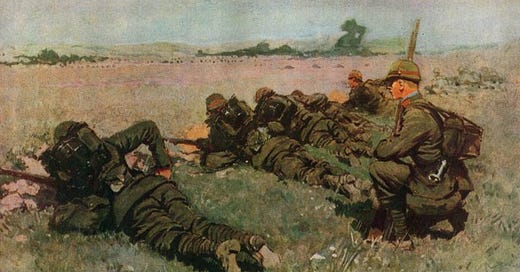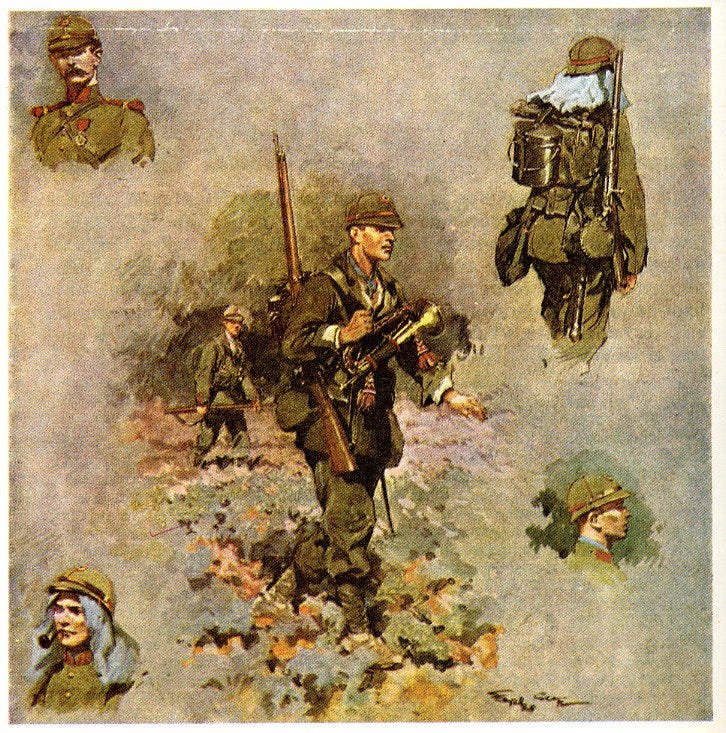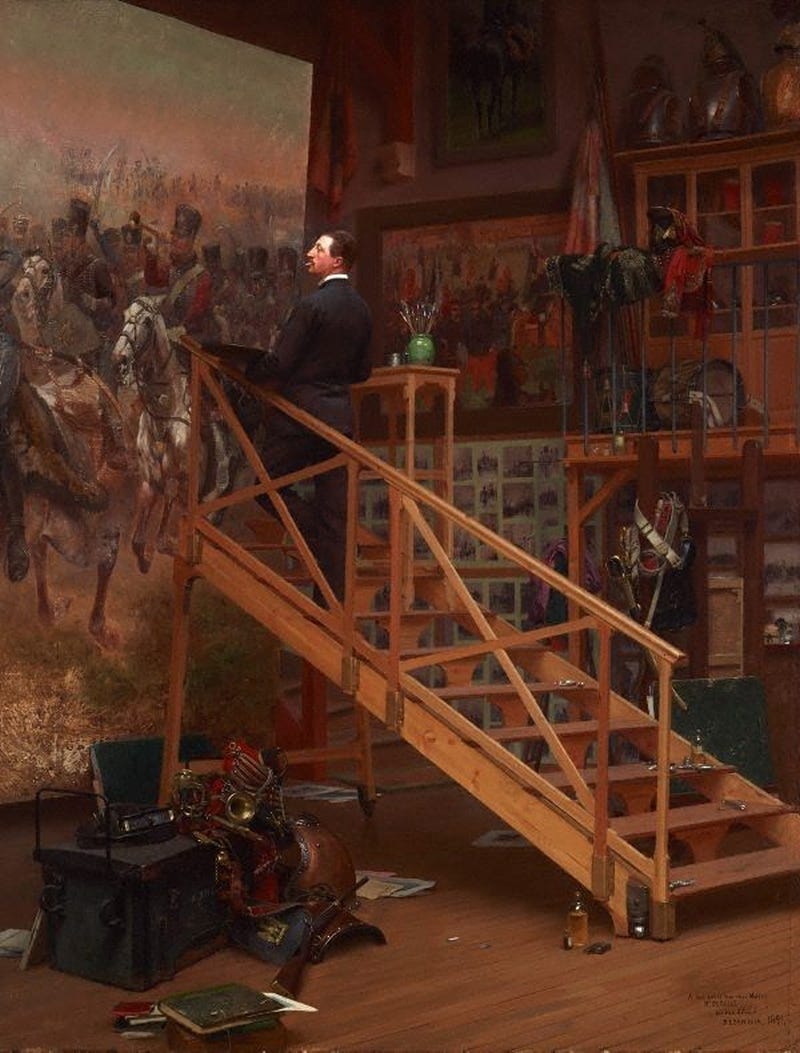The following is a verbatim translation of an article about French attempts to adopt drab uniforms in the years leading up to 1914.
Ever since the Boer War, the French have been trying to introduce a new field uniform which takes into account recent war experience, particularly the requirement for reduced visibility in combat. Up to this point, the main garment of the infantry field uniform has been the navy blue overcoat (capote). In cold weather, a jacket (veste) is worn underneath the overcoat. In other situations, [it is carried in the backpack or the company baggage wagon.
The tunic (tunique) was only for parades or as a guard duty and walking out uniform. Of particular note are the piou-piou - the red trousers and the red képi.
From the French side, the following was said about the current uniform: the képi protects neither the temples nor the neck from the sun, it becomes soaked in the rain and is, like the red trousers, visible from too far away. The overcoat is too long and heavy. It hinders the legs during marches, even when the skirts are turned back. The jacket is too short and fails to protect the lower torso. The tunic is superfluous because it is not taken into the field.
From 1903 to 1905 uniform experiments were carried out with a blouse-like grey-blue tunique, trousers of the same color, and a “Boer” hat. In 1906 a helmet was tested. Neither experiment led to any practical result.
After the German Imperial Maneuvers of 1910, where a large part of the troops wore a new field uniform, increased French attention was devoted to the question of drab uniforms. In October, 1910, the War Minister charged a commission chaired by General Dubail with solving the uniform question. The work of this commission resulted in a grey-green uniform, which the French press called the Reseda uniform, for all arms. Be cause this has been well covered in the press and from the first has been the subject of heated controversy, only a short description is required.
The cut of this uniform seems to be practical. The color is entirely grey green, the buttons are of painted metal. The infantry overcoat has two front pockets, a turndown collar, and a single row of buttons.
The current tunic is to be done away with, as is the jacket. The field coat (vareuse) which is to replace them resembles the coat of the Chasseurs Alpins. It has, however, a standing collar and four front pockets.
For summer wear, it is intended to replace the overcoat. For winter wear, it is to be worn under the overcoat. The epaulettes for enlisted men have been done away with. For parades and walking out, there are a pair of removable “shoulder pieces.” Trousers, puttees, and the rucksack-like backpack are made of the same grey-green material as the coat and overcoat. Leather equipment is undyed.
Instead of the képi, a grey-green cork helmet with front and back visors will be introduced. In peacetime, it will be provided with a removable metal ornament. In war, this will be replaced by the national cockade.
The uniforms of officers will differ from those of NCOs and men only by the quality of material and the rank insignia on the sleeves, which are only visible at short distances. The various arms and branches are to be distinguished by collar flashes and other small insignia.
This Reseda uniform was tested in the maneuvers of the VI. Army Corps of 1911 and proved itself to be practical, blending in well with the terrain. However, because of its unembellished appearance, it failed to find favor with the French people. Despite the many advantages of the new uniform, one could not rule out including the national colors of red and blue.
Reasons of this sort relate to steps taken since then. [Édouard] Detaille, the painter of battle scenes, was commissioned to design a field uniform that took these wishes of the people into account. Three different uniforms were previewed at the parade at Longchamp on the 14th of July, 1912.
The first two companies wore the grey-green Reseda uniform described above. Then came two companies in grey-blue uniforms proposed by the painter Detaille. With the latter, the traditional red trousers were retained. It consisted of a grey-blue overcoat, baggy field-blouse and puttees of the same color. For headgear, either a helmet or a kepi with leather trim to keep out the rain was worn. A fifth company wore a parade uniform (with a helmet, red trousers, and a tunique like those previously described) that had likewise been designed by Detaille.
The experiments were continued in the maneuvers of that year (1912) and have, as yet, done little to re solve the uniform question. In general, the previous uniform, with some changes, is to be retained. A blue-grey overcoat will replace the navy-blue overcoat. It will have a stand-and-fall collar, front pockets, and two rows of metal buttons, which, in order to reduce their visibility, will not be shined in the field. The short cloth jacket will be done away with. It will be replaced with a blue-grey field blouse which, in summer, will be worn instead of, in winter, worn under, the overcoat.
Because the uniform for wartime and peacetime will be the same, the [navy blue] tunic will apparently be done away with. For trousers, the red pants will be retained. It is believed that they will be rendered less visible by the overcoat and the leggings. For footwear, all foot troops will wear lace-up boots and leather leggings. Only the Chasseurs Alpins will keep their cloth puttees.
The question of headgear seems yet to be completely resolved. In order to make use of the large inventory of red képis, these will be provided with a grey-blue cover. In addition, experiments with helmets will continue.
The wish of the French people has been fulfilled. The French Army will, as before, take the field in the national colors of blue and red. The changes made certainly reduce the visibility of the uniform in the field. They cannot, however, as La France Militaire would have us believe, be considered as a satisfactory solution to the uniform question.
Source: Anonymous, “Bekleidung, Ausrüstung und Feldfahrzeuge der französischen Infanterie”, Viertelsjahrsheft für Truppenführung und Heereskunde, Heft 1, 1913, pages 158-162.








At what point did everyone divide their military attire into field, service, and dress uniforms? The idea that one uniform will work could not survive into the era of "radical lethality," at least in the USA and in other wealthy countries. But providing multiple uniforms is an expensive proposition. I suppose the Peoples Liberation Army of Vietnam used one uniform for everything, and they won all their wars.